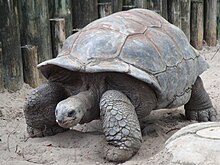
Back Landskilpad Afrikaans Byrdling ANG سلاحف برية Arabic فكرونه ARZ কাছ Assamese Testudinidae AST Quru tısbağaları Azerbaijani Сухапутныя чарапахі Byelorussian Сухоземни костенурки Bulgarian Totel Bislama
| Testudinidae Temporal range:
| |
|---|---|

| |
| Aldabra giant tortoise (Aldabrachelys gigantea) | |
| Scientific classification | |
| Domain: | Eukaryota |
| Kingdom: | Animalia |
| Phylum: | Chordata |
| Class: | Reptilia |
| Order: | Testudines |
| Suborder: | Cryptodira |
| Superfamily: | Testudinoidea |
| Family: | Testudinidae Batsch, 1788 |
| Type genus | |
| Testudo | |
Tortoises (/ˈtɔːr.təs.ɪz/) are reptiles of the family Testudinidae of the order Testudines (Latin for "tortoise"). Like other turtles, tortoises have a shell to protect from predation and other threats. The shell in tortoises is generally hard, and like other members of the suborder Cryptodira, they retract their necks and heads directly backward into the shell to protect them.[1]
Tortoises can vary in size with some species, such as the Galápagos giant tortoise, growing to more than 1.2 metres (3.9 ft) in length, whereas others like the Speckled cape tortoise have shells that measure only 6.8 centimetres (2.7 in) long.[2] Several lineages of tortoises have independently evolved very large body sizes in excess of 100 kg, including the Galapagos giant tortoise and the Aldabra giant tortoise. They are usually diurnal animals with tendencies to be crepuscular depending on the ambient temperatures. They are generally reclusive animals. Tortoises are the longest-living land animals in the world, although the longest-living species of tortoise is a matter of debate. Galápagos tortoises are noted to live over 150 years, but an Aldabra giant tortoise named Adwaita may have lived an estimated 255 years. In general, most tortoise species can live 80–150 years.
Tortoises are placid and slow-moving, with an average walking speed of 0.2–0.5 km/h.[citation needed]
- ^ Harris, Samantha. "How Strong Is A Tortoise Shell?". Tortoise Knowledge. Retrieved 23 January 2023.
- ^ encyclopedia of LIFE. Miles Kelly. 2017. p. 211. ISBN 978-1-78617-327-0.
© MMXXIII Rich X Search. We shall prevail. All rights reserved. Rich X Search